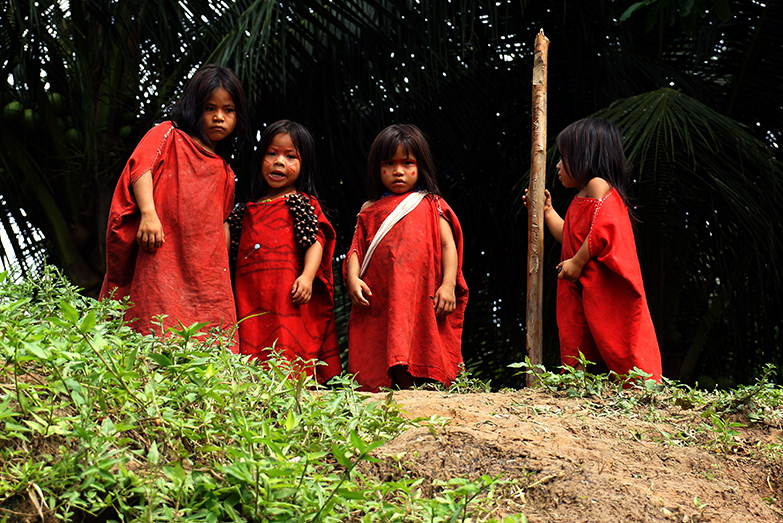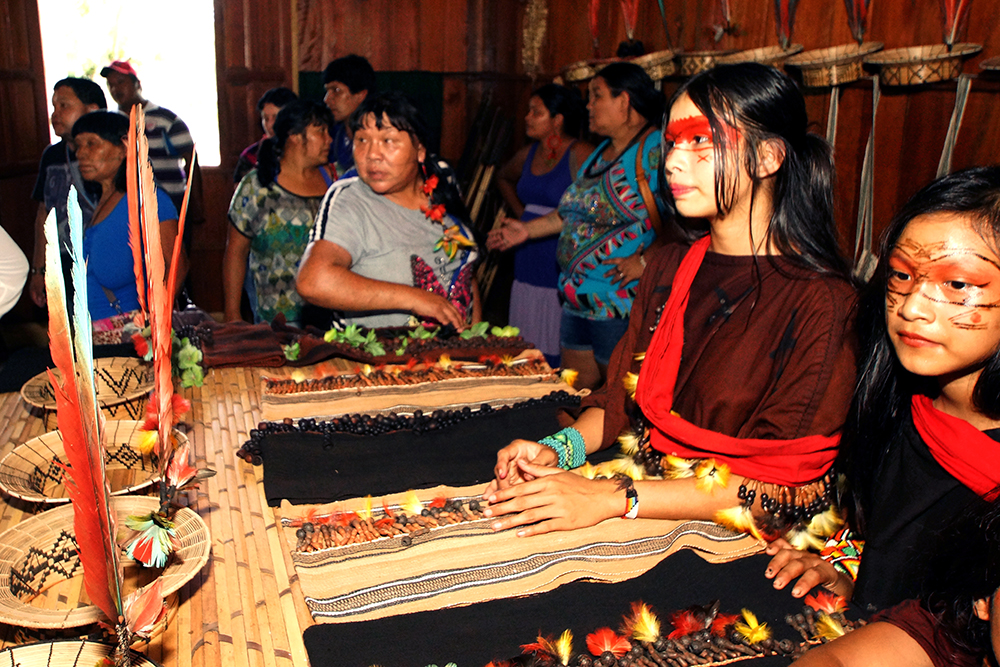
On a recent April day, the dense rainforest landscape of Acre, Brazil teemed with the dizzying diversity of wildlife that usually inhabits it. One could hear birds chirping, frogs croaking, and monkeys howling. But in addition, on this morning the sounds of traditional melodious chanting echoed through this small corner of the Amazon, adding to the colorful symphony that fills the rainforest on any given day.
The reason for the occasion was that the Surui, the Yawanawa, and the Ashaninka, three indigenous people that call the Amazonian rainforest home, had come together in one place for a festival of cultural exchange, to inaugurate a traditional community center, or Shuhu, and to launch two new publications that had been produced with the support of Forest Trends’ Communities Initiative.
New Strategies for Adapting to Climate Change
This important cultural exchange was supported through the partnership between Forest Trends’ Communities Initiative and the IKEA Foundation. Bringing Yawanawa, Surui, and Ashaninka youth together to learn from each other how their cultural traditions influence the way they manage their forest homelands will not only contribute to their increased self-identify, but also identify new strategies to adapt to the challenges of climate change. Our work with the IKEA Foundation is helping us achieve this goal by creating better livelihood opportunities for indigenous women and youth, and by opening spaces for dialogue that are crucial for solidifying ties between these three groups who share the rainforest as their home. We are also working with these communities to develop new economic opportunities in ways that honor cultural heritage while also helping future generations succeed.
Women from the three communities also participated in the festival by sharing their experiences earning income from artisanal work and reflecting on how this complementary income is contributing to their livelihoods and benefiting their children. Two years ago the Surui women opened a handicraft store and have since then been selling handmade goods to buyers near and far.
In addition, the Yawanawa and Surui were able to see firsthand how the Ashaninka produce a great variety of fruit trees and other food crops in sophisticated and integrated cultivars, known as indigenous agroforestry systems. Through these systems the Ashaninka have reforested part of their homeland that in the past had been cleared by loggers, in the process restoring biodiversity and producing plenty of food for their people.

Indigenous Innovations Resonate around the World
The two publications introduced at the event play a similarly important role in helping these communities establish themselves and ensuring their resilience and survival in the 21st century. The Ashaninka Environmental Services Protocol – a recognized legal instrument under Brazil’s “Biodiversity Law” – reaffirms the role of the Ashaninka as guardians of 87,200 hectares of the Amazon. Moreover, the protocol lays out the safeguards to ensure that new projects strengthen the social structure of the Ashaninka while also managing their land sustainably.
Similarly, the Yawanawa Life Plan establishes how this tribe seeks to manage the 187,000 hectares of forests under their stewardship and defines their vision for community development. When the Yawanawa created their life plan, they involved everybody in the process – elders, women, and youth, all of whom shared their hopes for a common future.
“To awaken and connect humanity to nature. To bring change from within. To awaken to the world by showing who we are and see how we influence others. Through our values we can begin to talk about changing the world.” – Benki Piyako, Ashaninka Protocol
Communities as Architects of Their Own Development
The Yawanawa Life Plan has attracted keen interest within international circles. It was presented at a social media event sponsored by the National Alliance for Media Arts and Culture in Oxford, held in conjunction with the Skoll World Forum, and also most recently at the UN’s Permanent Forum on Indigenous Issues. And rightfully so: thriving forests are essential for maintaining a healthy climate. Half of the world’s rainforests are located in Latin America, and 25% of these forests have been inhabited and guarded by indigenous and traditional communities for generations. It is therefore essential that forest communities are actively involved when it comes to implementing conservation and climate solutions, such as those articulated in the Paris Agreement and the Sustainable Development Goals.
Documents such as the Yawanawa Life Plan and the Ashaninka Protocol play an important role for initiatives that seek to benefit indigenous communities while addressing urgent climate challenges. Similar efforts that will benefit forests and the communities who inhabit them are going on in places like California, where a proposal to expand access to the state’s cap and trade program to regional governments in the Amazon and elsewhere could fight climate change and support forest communities at the same time. All these ongoing efforts reflect an approach to development that emphasizes the values and norms of local communities that might otherwise be lost or overridden. Through these new publications and events like the Acre cultural exchange festival, the seeds for such alternative approaches can be planted and grow branches into the wider world.
Viewpoints showcases expert analysis and commentary from the Forest Trends team.
Connect with us on Facebook and Twitter to follow our latest work.
